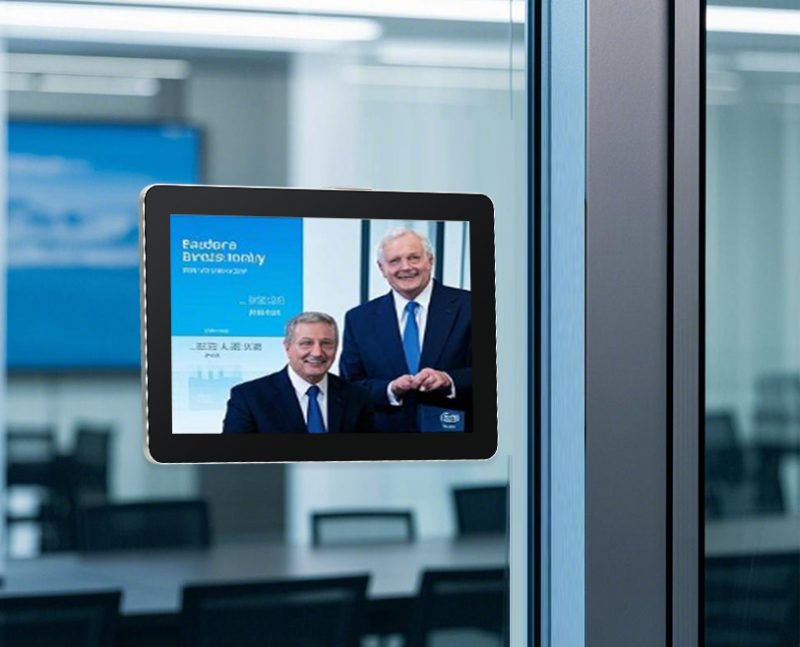In the era of automated automotive manufacturing—where precision, speed, and reliability of robotic systems directly impact production quality and output—Industrial Touchscreen Monitors for Auto Robotics have become a critical interface. Unlike consumer-grade touchscreens that fail under industrial stress or basic monitors with limited interaction, these specialized displays serve as the command center for auto robots, enabling operators to control, monitor, and troubleshoot robotic workflows with ease. For automotive manufacturers relying on robotic arms for welding, assembly, painting, and material handling, these touchscreens eliminate operational friction, تقليل وقت التوقف عن العمل, and ensure alignment between human operators and robotic systems. Whether deployed in high-volume assembly plants, precision component manufacturing facilities, or robotic testing labs, Industrial Touchscreen Monitors bridge the gap between human oversight and robotic automation. تستكشف هذه المقالة ميزاتها الأساسية, التطبيقات الرئيسية, والفوائد التحويلية, helping automotive operations and robotics teams select touchscreen solutions that elevate robotic performance and manufacturing efficiency.

Core Features of Industrial Touchscreen Monitors for Auto Robotics
1. Seamless Integration with Auto Robotic Systems
The defining advantage of Industrial Touchscreen Monitors is their ability to sync flawlessly with auto robotic hardware and software—critical for unified operations:
Robotic controller compatibility: Works with leading auto robotic brands (Fanuc, ايه بي بي, KUKA, Yaskawa) and their proprietary controllers, supporting protocols like PROFINET, إيثرنت/IP, and Modbus TCP.
Real-time data sync: Displays robotic metrics (على سبيل المثال, position, speed, torque) and workflow status instantly, with ≤1ms latency to avoid delays in control or troubleshooting.
Bidirectional control: Lets operators adjust robotic parameters (على سبيل المثال, welding current, pick-and-place precision) via touch, with changes reflecting in robotic systems immediately.
2. Rugged Construction for Auto Manufacturing Environments
Auto robotics workspaces are harsh—with vibration, تراب, chemicals, and physical impacts—and these touchscreens are engineered to endure:
Industrial-grade build: 3mm+ tempered glass front resists scratches from tools, robotic part debris, or accidental bumps from maintenance carts.
Environmental resilience: IP65-rated enclosures block dust, coolant mist, and minor fluid spills (على سبيل المثال, lubricants, paint thinners) common in robotic work cells.
Vibration and shock resistance: Compliant with IEC 60068-2-6 (اهتزاز) و IEC 60068-2-27 (shock) المعايير, maintaining performance amid robotic arm vibrations or tool drops.
3. Precise, Operator-Centric Touch Performance
Designed for auto robotics operators who need fast, accurate interaction—even with gloves or in high-pressure scenarios—these touchscreens prioritize usability:
Gloved-hand compatibility: Enhanced capacitive or infrared touch technology works with nitrile, latex, or cut-resistant gloves, eliminating PPE removal delays.
استجابة اللمس منخفضة الكمون (≤2ms): Ensures instant registration of taps for critical actions (على سبيل المثال, emergency stops, تعديلات المعلمة) to avoid robotic errors.
Customizable control interfaces: Tailored dashboards for specific robotic tasks (على سبيل المثال, “Welding Robot Control,” “Assembly Arm Monitoring”) display only relevant buttons and data.
4. High-Visibility Displays for Complex Robotic Data
Auto robotics require clear visualization of detailed data—from schematics to real-time metrics—and these touchscreens deliver uncompromised readability:
سطوع عالية (600+ القمل) panels: Cut through glare from welding sparks, overhead lights, or factory windows, ensuring robotic status and alerts are visible at a glance.
High-resolution (1920×1080) screens: Render detailed robotic arm schematics, weld path diagrams, and quality check overlays with crisp clarity for precision control.
Anti-glare and anti-fingerprint coatings: Reduce reflections and smudges, maintaining screen clarity during long shifts without frequent cleaning.
5. Reliable Connectivity & Redundant Backup
Uninterrupted access to robotic systems is non-negotiable—and these touchscreens ensure continuity:
Dual-network connectivity: Supports Ethernet and Wi-Fi (or cellular 4G/5G) for redundant connections, avoiding downtime if one network fails.
Offline operation mode: Stores critical robotic programs and troubleshooting guides locally, letting operators work even during plant network outages.
Remote management: Robotics managers update touchscreen software, dashboards, or robotic program templates remotely, reducing on-site maintenance time.
Key Applications of Industrial Touchscreen Monitors in Auto Robotics
1. Robotic Welding Control & Monitoring
In automotive welding cells—where precision and consistency are vital—these touchscreens serve as central command hubs:
Weld parameter control: Operators adjust voltage, current, and travel speed via touch, with real-time feedback on weld quality (على سبيل المثال, “Heat Input: Optimal”).
Weld path visualization: Displays pre-programmed weld paths on 2D/3D diagrams, letting operators verify paths before robotic activation to avoid errors.
Defect alerting: Triggers visual and audio alerts on the touchscreen for weld defects (على سبيل المثال, “Porosity Detected”) and logs data for root-cause analysis.
2. Robotic Assembly Line Operations
For auto component or vehicle assembly robots, these touchscreens streamline workflow coordination:
Part verification: Operators scan component barcodes via the touchscreen to confirm the correct part is loaded for robotic assembly, reducing misfits.
Assembly sequence control: Taps to start/pause robotic assembly steps (على سبيل المثال, “Install Engine Mounts,” “Attach Door Panels”) and adjust sequence if needed.
Production tracking: Displays units assembled, cycle times, and pending tasks to keep assembly lines aligned with production targets.
3. Robotic Paint Shop Control
In automated automotive paint booths—where environmental conditions are harsh—these touchscreens ensure consistent coating quality:
Paint application control: Adjusts robotic spray pressure, nozzle distance, and paint flow rate via touch, with presets for different vehicle parts (على سبيل المثال, hood, fenders).
Booth environment monitoring: Displays temperature, humidity, and airflow data (synced with booth sensors) to ensure optimal paint adhesion.
Color change management: Guides operators through robotic color change sequences via touch, with step-by-step prompts to reduce downtime between color batches.
4. Robotic Material Handling & الخدمات اللوجستية
For auto plants using robots for material transport (على سبيل المثال, moving parts to assembly lines), these touchscreens optimize efficiency:
Route planning: Operators set or modify robotic material transport routes via interactive maps on the touchscreen, adapting to floor traffic or equipment changes.
Load monitoring: Displays robotic load capacity and weight of transported materials, triggering alerts if overloaded to prevent damage.
Pick-and-place verification: Confirms robotic pick-and-place accuracy via barcode scans, ensuring parts are delivered to the correct assembly station.
Benefits of Industrial Touchscreen Monitors for Auto Robotics
1. Reduced Robotic Downtime & Increased Uptime
Downtime from robotic errors or slow troubleshooting is costly—and these touchscreens deliver rapid resolution:
Real-time alerts and diagnostic data cut unplanned robotic downtime by 35–45%, minimizing production delays.
Remote management lets technicians address software or dashboard issues without visiting the work cell, reducing maintenance time by 30%.
2. Improved Robotic Precision & Quality Output
Precise control and clear data visualization minimize robotic errors:
Touch-based parameter adjustments reduce weld, assembly, or paint defects by 50–60%, lowering rework costs and scrap rates.
3D path visualization ensures robotic movements align with design specs, improving component fit and vehicle quality.
3. Enhanced Operator Productivity & Safety
Intuitive design empowers operators to work smarter and safer with robots:
Customized dashboards reduce operator training time by 40% (vs. complex button-based controllers), getting new staff up to speed faster.
Built-in emergency stop buttons and safety alert prompts on the touchscreen reduce robotic safety incidents by 45%, adhering to ISO 10218 المعايير.
4. Streamlined Compliance & Traceability
Auto manufacturers face strict quality and safety regulations—and these touchscreens simplify adherence:
Automatically logs robotic parameters, operator actions, and defect data, creating comprehensive audit trails for IATF 16949 and ISO 9001.
Data sync with MES (Manufacturing Execution Systems) links robotic performance to specific vehicle VINs or component batches for full traceability.
FAQs About Industrial Touchscreen Monitors for Auto Robotics
س 1: Will these touchscreens work with our existing Fanuc or ABB robotic controllers?
A1: Yes. They integrate seamlessly with all leading auto robotic brands and controllers. Our team tests compatibility with your specific setup and handles integration.
Q2: Can the touchscreens withstand the heat and sparks from robotic welding cells?
A2: قطعاً. Welding-specific models feature heat-resistant housings (up to 100°C) and spark-deflecting glass shields, ensuring reliable performance in welding environments.
س 3: How secure is the data transmitted between the touchscreen and robotic systems?
A3: Data is encrypted via SSL/TLS, with role-based access controls (RBAC) to restrict sensitive robotic programs or parameters to authorized operators only.
س 4: What is the typical lifespan of these touchscreens in a 24/7 auto robotics environment?
A4: With industrial-grade components, they last 8–10 years in continuous operation. Most models include a 3–5 year warranty covering hardware defects.
س5: Can we customize the touchscreen interface for different robotic tasks (على سبيل المثال, welding vs. assembly)?
A5: Yes. We create task-specific dashboards with tailored controls, data visualizations, and alerts. Cloud-based updates let you modify interfaces as production needs change.
خاتمة
Industrial Touchscreen Monitors are the backbone of efficient, precise auto robotics—delivering seamless integration, rugged durability, and intuitive control that consumer-grade displays simply can’t match. For automotive manufacturers looking to maximize robotic uptime, improve quality, and empower operators, these touchscreens are a strategic investment that translates to tangible production gains and cost savings. Whether controlling welding robots, streamlining assembly lines, or managing paint shop automation, Industrial Touchscreen Monitors ensure human operators and robots work in perfect harmony.
Ready to optimize your auto robotics operations with high-performance industrial touchscreen monitors? Fill out the form on our website to connect with our automotive robotics technology experts. We’ll assess your existing robotic systems, demonstrate integration capabilities, and provide a customized solution proposal—helping you boost productivity, reduce defects, and elevate your automated manufacturing workflows.

